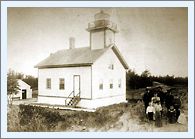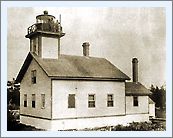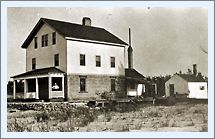|
Historical Information

While the discovery of iron ore would soon cause the ports of
Duluth/Superior and Marquette to assume the role of Superior's
preeminent ports, in 1850 the bustling fur trading center at La Pointe
on Madeline Island served as the lake's hub of maritime commerce.
Although the harbor at LaPointe was protected from deadly Superior
Nor'westers by its situation in the lee of the Apostle Islands, and from
Northeasterly blows by the body if Madeline Island itself, entry into
the harbor was no simple task from any direction.
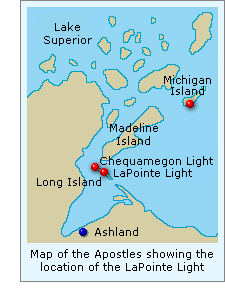 Captains
making for La Pointe from the east were forced to thread the needle
through the narrow South Channel between Long Island and the southerly
tip of Madeline Island, before swinging northwest into more open water,
and thence to the harbor at LaPointe. Vessels wishing to avoid the South
Channel by swinging around the northerly end of Madeline Island were
forced instead to negotiate between the Madeline coast and Michigan,
Stockton, and Basswood Islands before swinging south to LaPointe. Given
the choice, almost all captains chose the route through the South
Channel, since it was a considerably shorter distance. Shorter distances
meant less time, and even in the mid nineteenth century commercial
captains were only too aware of the fact that time was money. While
making the passage through the South Channel under sail was difficult
under the best of conditions, without the benefit of a light to mark the
westerly tip of Long Island, the task was formidable under darkness or
in thick weather of any kind. Captains
making for La Pointe from the east were forced to thread the needle
through the narrow South Channel between Long Island and the southerly
tip of Madeline Island, before swinging northwest into more open water,
and thence to the harbor at LaPointe. Vessels wishing to avoid the South
Channel by swinging around the northerly end of Madeline Island were
forced instead to negotiate between the Madeline coast and Michigan,
Stockton, and Basswood Islands before swinging south to LaPointe. Given
the choice, almost all captains chose the route through the South
Channel, since it was a considerably shorter distance. Shorter distances
meant less time, and even in the mid nineteenth century commercial
captains were only too aware of the fact that time was money. While
making the passage through the South Channel under sail was difficult
under the best of conditions, without the benefit of a light to mark the
westerly tip of Long Island, the task was formidable under darkness or
in thick weather of any kind.
Wisconsin Senator Orasmus Cole took up
the cause of maritime interests on February 8, 1851, when he presented a
memorial before Congress on behalf of the Wisconsin Legislature praying
"for an appropriation to build a light-house at La Pointe, on the
southern shore of Lake Superior." Congress appropriated $5,000 for
the construction of the LaPointe light on March 3, 1853, and by the end
of that year plans for the station had been drawn up, a site was
selected, and steps were underway to obtain title for the reservation.
However, as a result of a series of government blunders, the light which
was built in 1857 to satisfy the appropriation was mistakenly built on
Michigan Island, and since no keepers were ever assigned to the station,
it appears likely that it was never truly placed into service. To
recover from the error, plans were quickly arranged to build a station
on the northwestern end of Long Island, as originally specified in the
appropriation.
In accordance with the original
specifications for the LaPointe Light, the station erroneously built on
Michigan Island by Milwaukee contractors Sweet, Ranson, and Shinn
consisted of a substantial stone dwelling and attached stone tower.
Since all of the $5,000 appropriation had been spent at Michigan Island,
there were no additional funds appropriated for the light now needed to
be built on Long Island. As a result, construction costs were kept to a
bare minimum through the erection of a simple wood frame combination
keepers dwelling and light tower. Under normal circumstances, such an
insubstantial structure would have been considered unsuitable for such
an exposed location, however the Eleventh District was "under the
gun" to deliver the station as authorized by Congress, and
accommodations were necessarily made to recover from the error. Whether
the costs of the new station were born by Sweet, Ranson and Shinn,
whether or they were hidden within other projects being undertaken in
the Eleventh District at the time, we have been unable to determine,
however the LaPointe Light was finally built in 1858 on a slight rise
approximately 400 yards from the northwesterly tip of the island.
The
clapboard-sided 1½-story structure was erected on a square timber
foundation, and incorporated a short tower integrated into one end of
the roof. With the top of the tower standing only 34 feet above the
foundation, the octagonal cast iron lantern was outfitted with a fixed
red Fourth Order Fresnel lens at a focal plane of 52 feet by virtue of the
building's location on slightly elevated ground, in turn affording the
light a visible range of 12 miles in clear weather. The combination of
the timber foundation and the sand on which it stood proved to be
problematic after only five years. High winds were found to be blowing
the sand away from beneath the foundation timbers, creating an unstable
condition through which it was feared that the building might soon be
completely undermined and collapse. In order to effect a solution, a
crew arrived on Long Island in 1864 and installed cast iron pipe
supports on stone piers beneath the building to provide support for the
foundation timbers. However, during his annual inspection of lights in
the district the following year, the Eleventh District Inspector
reported that the problem was not completely solved, and he recommended
that the sand around the foundation be covered with a layer of broken
stone to help minimize continued erosion.
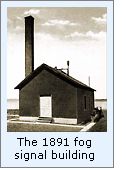 A
contract was awarded for the procurement, transportation and
installation of the crushed stone in 1866, but it was not quarried on
Raspberry Island and delivered to Long Island until late in 1868, where
all 50 cords sat in piles until the following year, when they were
finally crushed and distributed around the building foundation. While
the project took considerably longer than expected, it appears to have
been successful, since in his report for 1869, the District Inspector
reported simply that the repair was "effectual." With maritime
traffic patterns changing to the north of Madeline Island, in that same
year the Lighthouse Board decided to activate a fixed white light in the
Michigan Island lighthouse, which had been sitting unused since its
construction in 1857, and at the same time the characteristic of the
LaPointe light was changed to fixed red, in order to better
differentiate the two stations. A
contract was awarded for the procurement, transportation and
installation of the crushed stone in 1866, but it was not quarried on
Raspberry Island and delivered to Long Island until late in 1868, where
all 50 cords sat in piles until the following year, when they were
finally crushed and distributed around the building foundation. While
the project took considerably longer than expected, it appears to have
been successful, since in his report for 1869, the District Inspector
reported simply that the repair was "effectual." With maritime
traffic patterns changing to the north of Madeline Island, in that same
year the Lighthouse Board decided to activate a fixed white light in the
Michigan Island lighthouse, which had been sitting unused since its
construction in 1857, and at the same time the characteristic of the
LaPointe light was changed to fixed red, in order to better
differentiate the two stations.
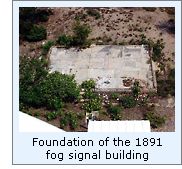 To help the station serve during
pea-soup fogs which frequently enveloped the area, $15,000 was requested
for a steam fog signal on the island in 1888, and while Congress granted
its approval for the project that same year, it failed to appropriate
the necessary funds for construction until March 2, 1889. A site for the
new facility was selected approximately three quarters of a mile east of
the Light, and contracts for a pair of ten-inch steam whistles and the
necessary building materials were awarded. While all materials arrived
at the Detroit depot early in 1890, clear title to the selected site was
not obtained until late that summer, and thus construction did not begin
until October, when the materials were loaded on the steamer RUBY and
transported to the LaPointe work site. Likely as a result of
unseasonably mild temperatures, work on the fog signal continued
throughout the winter, was completed in January of 1891, and placed into
active service with the arrival of an assistant keeper to the station in
March of that year. The signal was assigned a repeated thirty second
characteristic, consisting of a five-second blast followed by 25 seconds
of silence echoing across the lake during thick weather. That first
year, the signal was in operation some 189 hours, with the station's
hungry boilers consuming 12 tons of coal. To help the station serve during
pea-soup fogs which frequently enveloped the area, $15,000 was requested
for a steam fog signal on the island in 1888, and while Congress granted
its approval for the project that same year, it failed to appropriate
the necessary funds for construction until March 2, 1889. A site for the
new facility was selected approximately three quarters of a mile east of
the Light, and contracts for a pair of ten-inch steam whistles and the
necessary building materials were awarded. While all materials arrived
at the Detroit depot early in 1890, clear title to the selected site was
not obtained until late that summer, and thus construction did not begin
until October, when the materials were loaded on the steamer RUBY and
transported to the LaPointe work site. Likely as a result of
unseasonably mild temperatures, work on the fog signal continued
throughout the winter, was completed in January of 1891, and placed into
active service with the arrival of an assistant keeper to the station in
March of that year. The signal was assigned a repeated thirty second
characteristic, consisting of a five-second blast followed by 25 seconds
of silence echoing across the lake during thick weather. That first
year, the signal was in operation some 189 hours, with the station's
hungry boilers consuming 12 tons of coal.
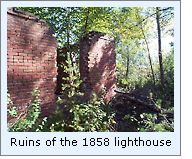 By the last decade of the nineteenth
century, it became clear that the diminutive 34-foot tall tower of the
LaPointe light was no longer serving the needs of maritime traffic
passing between Madeline, Stockton and Michigan Islands. Located too far
to the west, it was obscured by the southern tip of Madeline Island
until vessels were almost on top of it. In 1890 the Lighthouse Board
proposed that $7,500 be appropriated to replace the old light with a new
70-foot tall iron tower to be located next to the fog signal building.
Since this new light would be located over a mile from the northwestern
tip of Long Island, it was simultaneously proposed that a small light
and fog bell be constructed on Chequamegon Point at the northwestern tip of the island to
mark the full extremity of the south shore of the passage. Estimating
that this second structure could be built for $2,500, the Board
requested a total appropriation of $10,000 for the full improvements at
Long Island. By the last decade of the nineteenth
century, it became clear that the diminutive 34-foot tall tower of the
LaPointe light was no longer serving the needs of maritime traffic
passing between Madeline, Stockton and Michigan Islands. Located too far
to the west, it was obscured by the southern tip of Madeline Island
until vessels were almost on top of it. In 1890 the Lighthouse Board
proposed that $7,500 be appropriated to replace the old light with a new
70-foot tall iron tower to be located next to the fog signal building.
Since this new light would be located over a mile from the northwestern
tip of Long Island, it was simultaneously proposed that a small light
and fog bell be constructed on Chequamegon Point at the northwestern tip of the island to
mark the full extremity of the south shore of the passage. Estimating
that this second structure could be built for $2,500, the Board
requested a total appropriation of $10,000 for the full improvements at
Long Island.
Since
the LaPointe keepers would soon be responsible for two lights and a fog
signal, it was also determined that a full-time assistant keeper would
need to be assigned to the station to keep up with the workload, and
thus additional living quarters would need to added. In an attempt to
keep costs within the appropriated amount, it was decided to convert the
existing LaPointe lighthouse into a duplex dwelling, since with the
construction of the two new lights the old structure would otherwise no
longer serve any purpose. To this end, the lighthouse tender AMARANTH
delivered a work party to Long Island in the summer of 1896, and the
entire LaPointe lighthouse was jacked-up, and a brick basement
constructed beneath and the interior of the structure reconfigured to
accommodate two keepers. Amazingly, the light atop the roof was kept in
operation throughout the entire reconstruction, and thus the expense of
building a temporary tower was also avoided.
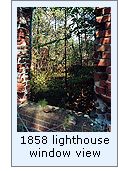 The old lighthouse thus remodeled,
continued to serve as the only dwelling for the Keepers of the new
LaPointe light station until
the construction of a new dwelling close to the new light in 1938 as a Works Progress
Administration project. At this time
a work crew
arrived on the island and built a large modern three-family dwelling
close to the LaPointe Light and fog signal, permitting a more efficient
grouping of the structures which made up the station. The old lighthouse thus remodeled,
continued to serve as the only dwelling for the Keepers of the new
LaPointe light station until
the construction of a new dwelling close to the new light in 1938 as a Works Progress
Administration project. At this time
a work crew
arrived on the island and built a large modern three-family dwelling
close to the LaPointe Light and fog signal, permitting a more efficient
grouping of the structures which made up the station.
No longer serving
any purpose, the old structure was abandoned, and without continued
maintenance deteriorated quickly. Today, all that remains of the old
LaPointe Lighthouse are the crumbling walls shown in the accompanying
photographs.

Keepers of
this Light

Click here
to see a complete listing of all LaPointe Light keepers compiled by
Phyllis L. Tag of Great Lakes Lighthouse Research.

Seeing this Light

For five
days in July, 2002, we were privileged to serve as NPS volunteers,
assisting Park Historian Bob Mackreth in documenting the condition of
all the Apostle Islands Lights, and visited Long Island in a Boston
Whaler on the afternoon of our first day in the Apostles after spending
the morning on Outer Island. Tying the boat to the concrete dock in
front of the station, we first photographed the new tower, dwelling and
oils storage house before setting off for the 3/4 mile trek to the ruins
of the old lighthouse.
It was 95 degrees that
day, and the walk out along the ridge was difficult going since all
remnants of the pathway were overgrown by stubby evergreens. We could
see no evidence remaining of the concrete walks which used to join the
dwelling to the new station, and could not identify whether they had
been removed or were just hidden beneath the island sand and vegetation.
After photographing the
old dwelling, we made our way back to the dock, and spent the next ten
minutes removing ticks from our legs before boarding the Whaler for the
trip back to Bayfield.

Finding this Light

At
this time, the LaPointe Light is the only lighthouse in the Apostles which
is not open to the public on a regular basis. However, the island itself
is open to the public, and with a private boat with which to land on the
island, good views of the exteriors of the new tower, Chequamegon Point
and the ruins of the remodeled dwelling can be obtained.

Contact information

While Apostle
Island Cruise Service offers daily trips around the islands,
passing close to the island for photography, it is only during the two
weeks of the annual Keeper of The Light festival in September that they
offer landings on Long Island. Apostle Island Cruise Services may be
contacted at the following address:
P.O. Box 691 - City
Dock
Bayfield, WI 54814
Telephone: (800) 323-7619
Email: info@apostleisland.com
For information on the Keeper
Of The Light Celebration, contact:
PO Box 990 19 Front St.
Bayfield, WI 54814
Telephone: (800) 779-4487

Historical
references

 Annual reports of the lighthouse Board, various, 1853 - 1909 Annual reports of the lighthouse Board, various, 1853 - 1909
Annual reports of the Lighthouse Service, various, 1910 - 1953
Great Lakes Light Lists, various, 1861 - 1977
Annual reports of the Lake Carrier's Association, various, 1906 -
1940
Recent photograph courtesy of Ken & Barb Wardius, Dan Tomhave &
NPS.
Historic photographs courtesy of the NPS Apostle Islands historians offices.
Email correspondence with Bob Mackreth NPS, various, January &
February 2002
Personal observations while on Long Island in July, 2002.
Keeper listings for this light appear
courtesy of Great
Lakes Lighthouse Research
|
